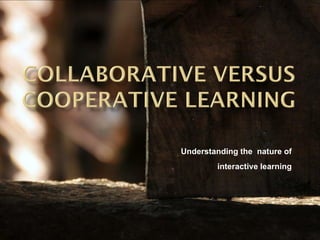
Understanding the Nature of Interactive Learning
- 1. Understanding the nature of interactive learning
- 2. Many of the "The structural approach to cooperative learning elements of is based on the creation, analysis and systematic cooperative application of structures, or content-free ways of learning may organizing social interaction in the classroom. Structures usually involve a series of steps, with be used in proscribed behavior at each step. An important collaborative cornerstone of the approach is the distinction situations. between "structures" and "activities". Spencer Kagan in an article in Educational Leadership (Dec/Jan 1989/1990)
- 3. Collaboration is a philosophy whereas of interaction and personal lifestyle • Cooperation is a structure of interaction designed to facilitate the accomplishment of an end product or goal.
- 4. In all situations where people come together in groups The underlying premise of collaborative learning is • it suggests a way of dealing based upon consensus with people which respects and highlights individual group building through cooperation members' abilities and by group members, in contributions. contrast to competition in • There is a sharing of authority which individuals best other and acceptance of responsibility group members. among group members for the groups actions not just a classroom technique
- 5. in the classroom apply this philosophy: at committee meetings with community groups within their families generally as a way of living with and dealing with other people.
- 6. more directive than a is defined by a set of processes which help collaborative system people interact together in order to accomplish a specific goal or develop an end product which is usually content specific. closely controlled by the teacher the fundamental approach is teacher centered
- 7. the teacher maintains complete control of the class, even though the students work in groups to accomplish a goal The cooperative teacher asks a specific question of a course. The teacher provides additional articles for www.worksheetlibrary.com/.../imagecoopgif.gif the students to read and analyze the groups present their results to the whole class and discuss their reasoning. to help facilitate the group interactions, the teacher might use specific structures. the teacher maintains control of the process at each stage of the students work.
- 8. the groups would assume almost total responsibility for answering the question the students determine if they had enough information to answer the question. The collaborative teacher assess the progress of each group and provide suggestions about each group’s approach and the data generated. The teacher would be available for consultations and would facilitate the process by asking for www.bournemouth.ac.uk/.../eres_image.png frequent progress reports from the groups The final product is determined by each group, after consultation with the teacher. The students develop a very strong ownership for the process
- 9. Learning Knowledge is discovered consists of by students and the underlying premise for both active transformed into concepts collaborative and cooperative learning is participation by students can relate to. It is founded in constructivist theory. the student then reconstructed and versus passive expanded through new acceptance of learning experiences information pre sented by an Learning comes about through expert lecturer. transactions and dialogue among students and between faculty and Students learn to understand students, in a social setting and appreciate different perspectives through a dialogue with their peers.
- 10. Panitz Ted; A Definition of Collaborative vs Cooperative Learning (1996) in http://www.londonmet.ac.uk/deliberations/collaborative- learning/panitz-paper.cfm visited in 27/10/2009 Panitz ,Ted, COLLABORATIVE VERSUS COOPERATIVE LEARNING- A COMPARISON OF THE TWO CONCEPTS WHICH WILL HELP US UNDERSTAND THE UNDERLYING NATURE OF INTERACTIVE LEARNING in http://home.capecod.net/~tpanitz/tedsarticles/coopdefinition.htm Visited in 27/10/2009 Science Education, What are the benefits of cooperative and collaborative learning ? http://www.thirteen.org/edonline/concept2class/coopcollab/i ndex.html visited in 14 /01/2010
- 11. made by Teresa Rafael PPEL/MPEL09 Universidade Aberta Fevereiro 2010
